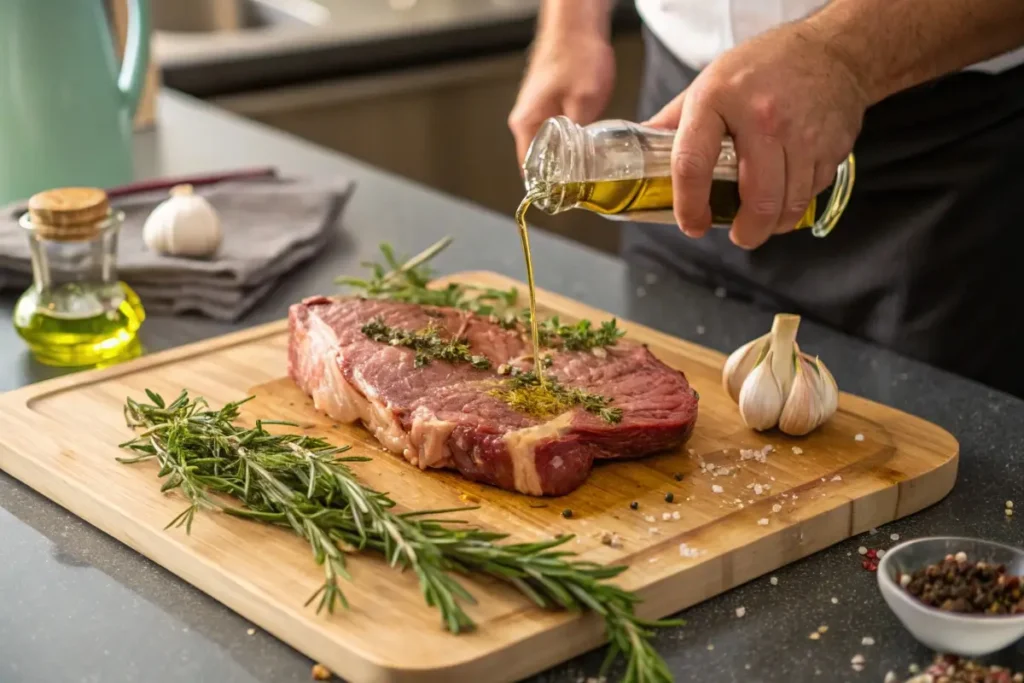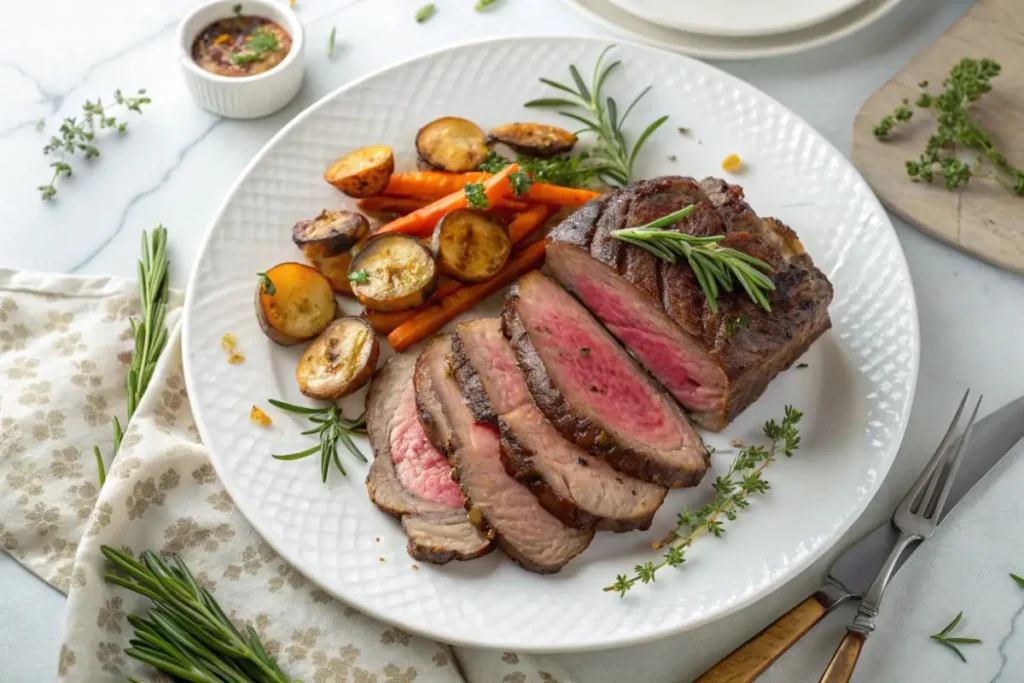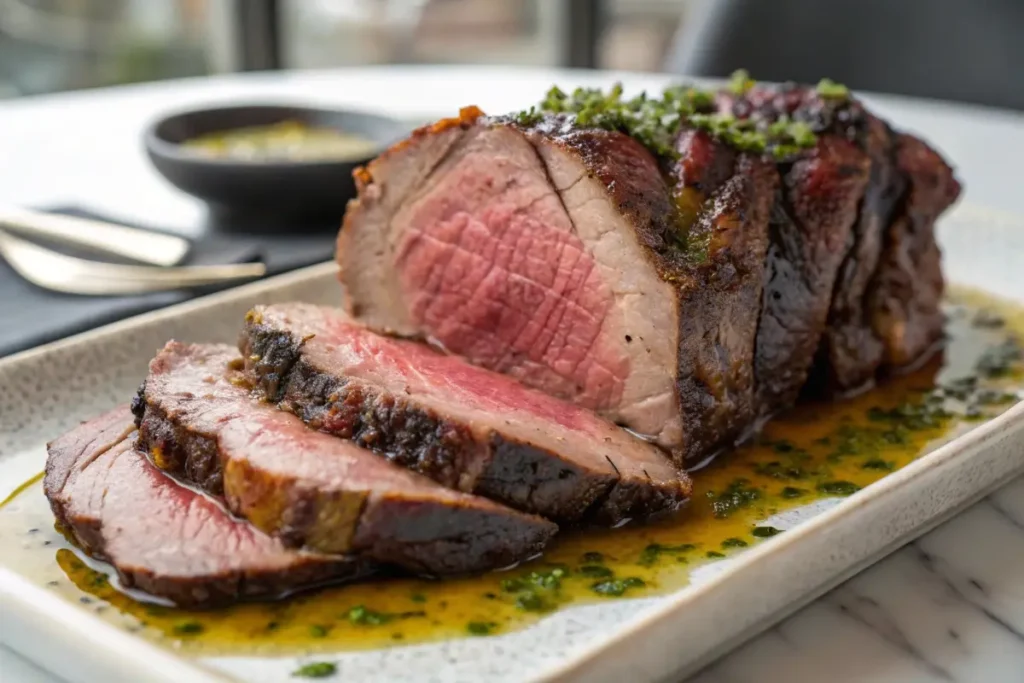Welcome to our ultimate guide on creating a mouthwatering ribeye roast recipe! In this article, we’ll walk you through everything—from choosing the perfect beef cut to mastering seasoning techniques and cooking methods. You’ll learn expert tips, discover versatile cooking approaches like oven roasting and slow cooking, and even get answers to common questions in our FAQs section. Whether you’re an experienced chef or just starting out in the kitchen, this guide is designed to help you craft a tender, juicy, and flavorful roast that will impress your guests every time. So, let’s dive in and explore the secrets behind the perfect roast!
Introduction to the Ribeye Roast Recipe
What is a Ribeye Roast?
A ribeye roast is a prized cut of beef, known for its abundant marbling and rich, succulent flavor. Originating from the rib section, this cut offers an ideal balance of fat and meat, which makes it incredibly tender when cooked right. It’s often celebrated as a prime rib roast, and many cooks swear by its versatility. For instance, whether you opt for an oven-roasted ribeye or a slow-cooked ribeye roast, you’re sure to enjoy a dish that bursts with savory taste and juicy texture. In fact, the natural fat in the ribeye melts during cooking, basting the meat and ensuring every bite is flavorful and moist.
Why This Ribeye Roast Recipe is a Must-Try
This ribeye roast recipe is not only straightforward but also brimming with expert advice and handy tips. Moreover, it’s designed to be both foolproof and adaptable, making it perfect for beginners and seasoned cooks alike. By following this recipe, you’ll learn how to properly season, marinate, and roast your beef to achieve that ideal tender texture and robust flavor. Additionally, the recipe incorporates essential techniques that help maintain moisture, ensuring that your roast is consistently juicy and satisfying. Ultimately, if you’re looking for a delicious beef roast recipe that transforms a simple cut into a culinary masterpiece, this is the one to try!
Choosing the Perfect Ribeye Roast
Selecting High-Quality Beef for Your Ribeye Roast Recipe
When you start your ribeye roast recipe, choosing the best beef is key. First, look for a cut with even marbling and a bright, fresh color. Moreover, ask your butcher about the meat’s source and quality. In addition, many chefs prefer cuts labeled as a prime rib roast because they tend to have more flavor. Furthermore, selecting high-quality beef not only makes the dish tastier but also ensures a tender result. Also, keep in mind that a well-chosen cut can significantly boost the overall success of your roast beef recipe. For example, a beef roast with good marbling will melt its fat during cooking, creating a succulent and juicy texture that you will love.
Prepping and Seasoning: Essential Tips Before Cooking
After picking the perfect cut, the next step is to prepare and season your meat. Firstly, pat the beef dry with paper towels to remove excess moisture. Then, generously season it with salt, pepper, garlic, and your favorite herbs. In addition, a light drizzle of olive oil helps the seasonings stick and enhances the oven-roasted ribeye flavor. Also, consider marinating the meat for a few hours or overnight, which can further boost its taste. Moreover, allow the beef to rest at room temperature for about 30 minutes before cooking. This simple step lets the meat heat evenly and helps it cook to perfection. Finally, these preparatory actions make your ribeye roast recipe not only flavorful but also easier to cook, ensuring a delicious and juicy outcome.
Essential Ingredients and Tools for a Delicious Ribeye Roast Recipe
Must-Have Ingredients and Seasonings for a Ribeye Roast
For an outstanding ribeye roast recipe, the right ingredients are a must. First, aside from your beef, gather simple seasonings like salt, pepper, and garlic. Next, add fresh herbs such as rosemary and thyme to give your roast a natural, aromatic flavor. In addition, a splash of olive oil is essential for marinating and keeping the meat moist. Moreover, butter can be used to baste the roast, which helps form a delicious crust. Also, a dash of lemon juice or red wine may be added to elevate the flavor further. Consequently, these ingredients work together to create a herb-crusted ribeye that is both visually appealing and full of flavor. Furthermore, using these basic yet effective seasonings transforms your beef roast recipe into a meal that feels both classic and innovative.
Kitchen Tools and Equipment for the Perfect Roast
To nail your ribeye roast recipe, having the right tools is just as important as choosing great ingredients. First, use a sturdy roasting pan that distributes heat evenly. Next, a reliable meat thermometer is key to checking doneness, so you never overcook your beef. Additionally, a sharp carving knife will help you slice the meat with ease, ensuring every cut is clean. Moreover, tools like tongs, a basting brush, and even a marinade injector can add extra finesse to your cooking process. Also, a quality oven or slow cooker enhances the overall performance of your roast beef recipe. In addition, prepping all your tools in advance makes the cooking process smoother and more enjoyable. Finally, by investing in these essential kitchen tools and following each step carefully, you can make sure your ribeye roast recipe turns out perfectly every time, leaving you and your guests impressed with a tender and flavorful meal.
Step-by-Step Cooking Process for the Ribeye Roast Recipe

Detailed Preparation: Trimming, Marinating, and Seasoning Your Ribeye
First, start by trimming any excess fat from your ribeye roast, but leave enough to enhance the flavor. Next, gently pat the meat dry, and then apply your chosen seasonings. For example, combine salt, pepper, garlic, and herbs like rosemary and thyme. Then, drizzle a little olive oil over the meat to help the spices stick. Moreover, if you have time, marinate your roast in the fridge for at least a couple of hours or overnight. In addition, this step not only boosts the flavor but also helps tenderize the meat. Overall, following these simple yet effective tips ensures that your ribeye roast recipe delivers a savory and juicy experience.
Cooking Techniques: Oven Roasting vs. Slow Cooking Methods
Now, let’s talk about the cooking methods. First, if you prefer a classic approach, oven roasting is the way to go. Preheat your oven to a moderate temperature, and then place the roast in a well-heated pan. Next, make sure to baste the meat regularly with its own juices or a butter-herb mixture. Alternatively, slow cooking offers a hands-off approach. In this method, the roast simmers gently over several hours, which allows the flavors to deepen and the meat to become extra tender. Moreover, slow cooking is ideal if you’re planning ahead or want a fuss-free meal. Therefore, whether you choose to roast in the oven or opt for slow cooking, you can achieve a tender and flavorful result that will make your ribeye roast recipe shine.
Temperature and Timing Guidelines for a Tender Roast
Then, it’s time to set the right temperature and timing. First, use a reliable meat thermometer to check the internal temperature of your roast. For medium-rare, aim for an internal temperature of around 135°F, and for medium, about 145°F. Meanwhile, keep in mind that every oven may vary, so adjust your cooking time accordingly. Next, let the roast rest for at least 10-15 minutes after cooking. This resting period allows the juices to redistribute, which leads to a more moist and tender bite. Additionally, remember that small differences in temperature and time can make a big difference in texture and flavor. Finally, by following these simple guidelines, your ribeye roast recipe will produce a roast that is both tender and irresistibly delicious.
Serving Suggestions and Presentation for Your Ribeye Roast Recipe

Complementary Side Dishes and Sauces for Roast Beef
First, serve your roast with sides that balance its rich flavor. For instance, pair your ribeye roast recipe with roasted vegetables like carrots and potatoes. Additionally, a crisp green salad can provide a refreshing contrast. Moreover, consider adding a light gravy or a tangy horseradish sauce that enhances the beef’s natural taste. In short, the right sides can make your meal more balanced and satisfying.
Plating, Garnishing, and Presentation Tips
Next, presentation is key. Start by slicing the roast evenly, so each serving shows off its juicy interior. Then, arrange the slices neatly on a warm plate. Furthermore, add a sprinkle of fresh herbs such as parsley or rosemary on top for a burst of color. In addition, a drizzle of olive oil or a small pat of herb butter can elevate the dish’s appeal. Finally, remember that a well-presented meal not only tastes great but also looks inviting, making your ribeye roast recipe a feast for both the eyes and the palate.
For more delicious recipes, check out our recipe article.
Expert Tips and Troubleshooting for the Best Ribeye Roast Recipe
Common Cooking Mistakes and How to Avoid Them
Many cooks often slip up when making a ribeye roast recipe, yet you can easily avoid these errors. First, over-seasoning is a common mistake that can hide the meat’s natural taste. Then, skipping the resting period before cooking may lead to uneven results. Furthermore, using too high a heat can dry out the roast, which is not what you want. Also, neglecting to use a meat thermometer might result in overcooked beef. In addition, rushing the marinating process can prevent flavors from fully developing. Therefore, by taking your time and following a steady, mindful approach, you can steer clear of these pitfalls and enjoy a roast that is both tender and flavorful.
Pro Tips for Enhancing Flavor and Texture in Your Ribeye Roast Recipe
First, always choose high-quality beef and fresh herbs to boost your dish’s taste. Next, try basting the roast regularly with its natural juices or a simple marinade, as this helps maintain moisture. Moreover, adding a small knob of butter during cooking can create a rich, savory crust. In addition, using a reliable meat thermometer ensures the meat is cooked to perfection. Finally, allow the roast to rest after cooking so that the juices settle, resulting in every slice being succulent and full of flavor.
FAQs
The two terms are often used interchangeably. Technically, prime rib refers to a rib roast with the bone in, while a ribeye roast is typically the boneless version of that same cut. Both deliver rich flavor and tenderness, but the presence of the bone in prime rib can add extra juiciness and flavor during cooking.
A: For a perfectly cooked ribeye roast, aim for an internal temperature of about 135°F for medium-rare or 145°F for medium. Additionally, many cooks sear the roast at a high temperature first, then reduce the heat to ensure even cooking. Using a meat thermometer is key to achieving the desired doneness.
Yes, searing a ribeye roast is highly recommended. Searing helps to lock in the juices and develops a flavorful crust that enhances the overall taste. Even though some slow-cook recipes might skip this step, searing generally improves both texture and flavor.
Absolutely! Ribeye is excellent for roast beef because of its abundant marbling, which provides a juicy, tender, and flavorful roast. Its rich taste makes it a favorite choice among chefs and home cooks alike, ensuring every bite of your ribeye roast recipe is delicious.
Conclusion: Final Thoughts on the Ribeye Roast Recipe

In conclusion, our journey through the ribeye roast recipe has been both fun and informative. Firstly, we explored the importance of selecting top-notch beef and preparing it with care, ensuring that every step adds to the final flavor. Then, we dove into the detailed cooking techniques—from trimming and marinating to choosing between oven roasting and slow cooking—so that every method can help you achieve a tender and juicy roast. Moreover, expert tips and troubleshooting advice were shared, which means you can avoid common pitfalls and enhance your dish’s texture and taste.
Furthermore, the FAQs provided extra insights to guide you in perfecting your roast, while our serving suggestions ensured that your meal not only tastes great but also looks inviting. Ultimately, whether you’re an experienced cook or just starting out, this ribeye roast recipe is designed to transform your kitchen routine into a delightful culinary adventure. So, give it a try, enjoy the process, and savor every bite of your delicious creation!

